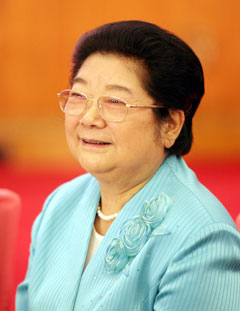|
'Inequality in jobs still a serious issue'
By Zhou Liming (China Daily)
Updated: 2006-03-08 05:52
At 46, she was New China's first female governor.
At 53, she was minister of chemical industry.
Now, as president of the All-China Women's Federation and vice-chairwoman of
the Standing Committee of the National People's Congress, Gu Xiulian, 69, keeps
a close eye on the year-to-year headway that women across China are making to
attain equal status with men in all walks of life.

Gu Xiulian,
vice-chairwoman of the Standing Committee of the National People's
Congress, attends a ceremony on Tuesday, March 7, 2006 to celebrate the
Women's Day in the Great Hall of the People.
[newsphoto] | As the nation celebrates the Internation Women's Day today, "inequality in
employment is still a serious issue," Gu said, citing the Labour Law that
employers should not raise the bar when recruiting women or reject them on
grounds of gender.
"I think the fundamental cause of gender discrimination is the incorrect idea
of 'female inferiority' which is ingrained in many people's minds," she said. "A
new gender culture should be cultivated to increase harmony between the sexes
and the government should explore market mechanisms that can promote women's job
prospects."
Gu admitted that it is a long and arduous task that requires input and
co-ordination from all government agencies: The labour department should monitor
the market; the legal department should provide aid that women can use as a
weapon to defend their rights; and unions, the Communist Youth League and the
women's federation should get involved in protecting women and their rights to
employment.
On the issue of domestic violence, Gu said that improving the legal system is
the best preventive measure because of the difficulty of obtaining criminal
evidence.
"Our litigation system does not sufficiently cover cases of domestic violence
and sexual harassment, and we also need to study ways to define these offences
and determine penalties," she noted.
Gu cited the 2005 resolution that clarified ways to end sexual harassment.
There are four channels which a victim can pursue for redress: first, file a
complaint with the employer of the offender; second, report to the local police;
third, file a civil lawsuit at the local court; and fourth, file a complaint
with the women's federation.
As domestic violence and sexual harassment tend to happen behind closed
doors, evidence does not come by easily. Besides better legal protection,
raising awareness is paramount in increasing women's capacity for
self-protection, she said. They should know, when victimized, how to retain
evidence and plead for assistance and not miss the window of opportunity when
evidence is still available.
Government organizations and State-owned enterprises should take the
initiative to abide by the law and nip these offences in the bud, Gu proposed.
On the work priorities for this year, Gu said that "high on the list is the
fight against poverty. We must protect the rights of women farmers in land use
and again in employment. Then, we are pushing to raise management skills for
women in public service.
"To further reduce the dropout rate for girls in remote areas and improve
health care for rural women and migrant women are also on the agenda.
"Of the things we are continuing to focus our attention on are women's rights
in marriage and family and kidnapping of women and children.?
In 1953, Gu left her Jiangsu home to attend school in the Northeastern city
of Shenyang. Her mother, who supported the family by weaving cloth on her
spinning wheel, was reluctant to let her go, but Gu wanted a proper education so
that she could help support the family.
Now she wants to make sure that every girl across the nation is guaranteed a
chance to schooling, and to the right to a job and freedom from violence and
harassment.
Significant progress made
Overall, Chinese women are making big strides in every area.
In 2004, women accounted for 44.8 per cent of all employment, or 336.9
million jobs, an increase of 12.52 million over 2000.
In the same year, childbirths at hospitals edged up 9.9 percentage points
over 2000, to 82.8 per cent. The rate of hospital delivery in rural areas jumped
11.9 percentage points, to 77.1 per cent.
During the same period, childbirth mortality dropped 9.6 per cent, from 53.4
to 48.3 per 100.
Life expectancy for women currently stands at 73.3, which is 3.9 years more
than men and close to that of advanced nations.
The gap in education between the sexes is also gradually narrowing.
For 2004, elementary school enrolment for girls was 98.93 per cent while that
for boys was 98.97 per cent. Women had an average of 7.51 years of education
while men had 8.5, a contraction from 1.9 years in difference for 2000. More
than 1 million women got off the illiteracy list. The goal set in "The Women's
Outline?to raise literacy levels above 85 per cent by 2010 was reached in 2003
when the rate for adult women reached 87.20 per cent.
(China Daily 03/08/2006 page1)
|